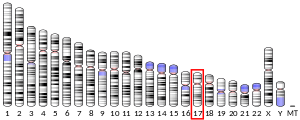OR1E3
Olfactory receptor family 1 subfamily E member 3 (gene/pseudogene) is a protein that in humans is encoded by the OR1E3 gene. [3]
Function
Olfactory receptors interact with odorant molecules in the nose, to initiate a neuronal response that triggers the perception of a smell. The olfactory receptor proteins are members of a large family of G-protein-coupled receptors (GPCR) arising from single coding-exon genes. Olfactory receptors share a 7-transmembrane domain structure with many neurotransmitter and hormone receptors and are responsible for the recognition and G protein-mediated transduction of odorant signals. The olfactory receptor gene family is the largest in the genome. The nomenclature assigned to the olfactory receptor genes and proteins for this organism is independent of other organisms. [provided by RefSeq, Jul 2008].
Odorant repertoire
Ketones, in particular acetophenone, act as agonists for OR1E3.[4]
From associations to other olfactory receptors, OR1E3 was found to be associated with the odor tendencies "medicine", "phenol", and "harsh".[5]
References
- GRCh38: Ensembl release 89: ENSG00000142163 - Ensembl, May 2017
- "Human PubMed Reference:". National Center for Biotechnology Information, U.S. National Library of Medicine.
- "Entrez Gene: Olfactory receptor family 1 subfamily E member 3 (gene/pseudogene)". Retrieved 2020-04-12.
- Matarazzo V, Clot-Faybesse O, Marcet B, Guiraudie-Capraz G, Atanasova B, Devauchelle G, et al. (March 2005). "Functional characterization of two human olfactory receptors expressed in the baculovirus Sf9 insect cell system". Chemical Senses. 30 (3): 195–207. doi:10.1093/chemse/bji015. PMID 15741602.
- Audouze K, Tromelin A, Le Bon AM, Belloir C, Petersen RK, Kristiansen K, et al. (2014). "Identification of odorant-receptor interactions by global mapping of the human odorome". PLOS One. 9 (4): e93037. Bibcode:2014PLoSO...993037A. doi:10.1371/journal.pone.0093037. PMC 3973694. PMID 24695519.
This article incorporates text from the United States National Library of Medicine, which is in the public domain.

